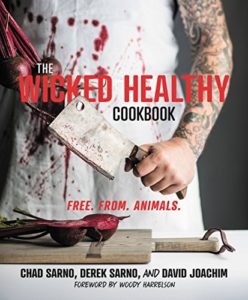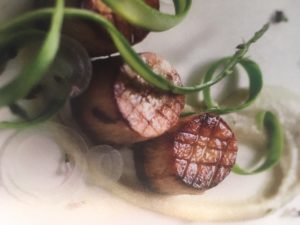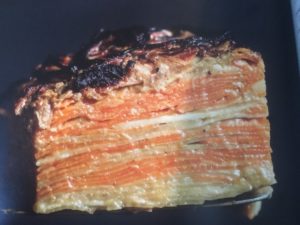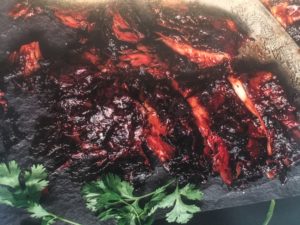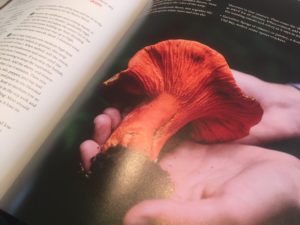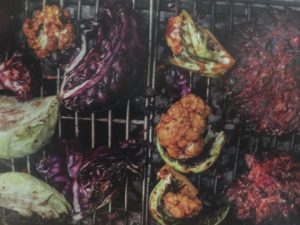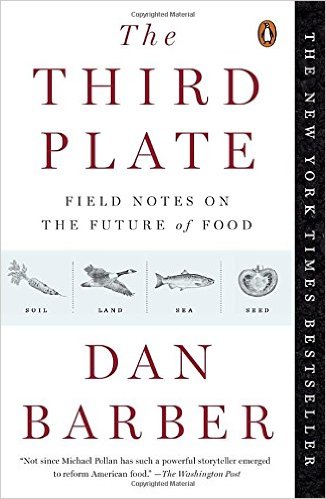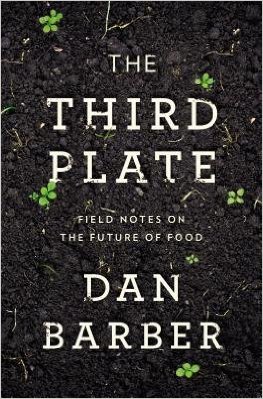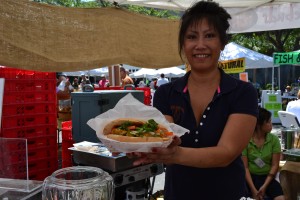Tag Archives: organic produce
What We Eat
“Eat food, not too much, mostly plants.” –Michael Pollan
After over a decade on a whole-foods, plant-based diet – with long-term forays into oil-free as well – we started to take stock and make some changes. Neither of us had lost any weight, despite a reasonable exercise regime – and didn’t feel as energetic as we’d like. We were also concerned about brain health, sufficient quality Omega-3s, and took a lot of cues from the lifestyles of the “blue regions.”
To be clear, we don’t believe that there is any one diet that works for everyone. But there are some basic underlying givens – organic and non-GMO to start. The Environmental Working Group’s Dirty Dozen (or 18) and Clean 15 list (ewg.org) is the place we start to decide where to spend our organic food dollars. To augment what we get weekly from our CSA.
To change from such a long-time vegan lifestyle was not easy, but we both agreed it was time, We started by just adding a little fish to our diet to ensure quality omega-3s. But not just any fish or seafood – we made a list based on, again, the Environmental Working Group’s (ewg.org) high omega 3s and low mercury list combined with the Monterey Aquarium’s sustainability list. Those lists have since been combined so there is now just one easy source (ewg.org). With a couple minor exceptions, these are all wild-caught seafood from sustainable populations. We also have a secondary list that is not particularly beneficial, but not particularly harmful – either to us or to the environment. Clams, shrimp, even the occasional lobster lands on that treat list – but still, all wild caught. Nothing farmed, except for Rainbow Trout or from the evolving totally land-locked aquaculture community.
Our friends were delighted! Entertaining us was now so much easier. To accommodate our diet, they happily centered meals on wild-caught Alaskan salmon and everyone at the table was content.
After a year or so, we decided to look further. While we had lost weight on five-day all-organic juice and smoothie fasts, we inevitably gained it all back. We both wanted to lose about 15 pounds – permanently – to be healthier, look better, and regain large swaths of our closets. So we needed to find a diet that was satisfying for the long term and would also help us meet our weight goals.
We explored many options to find an approach that was grounded in evidence with a science that made sense. We decided to try Mark Hyman’s 21-day “Eat Fat, Get Thin” diet. It was pretty much life-changing for both of us. We found it very easy to follow, never felt deprived and started to lose weight – slowly and consistently. After our experiences on an oil-free plant-based diet, and having been steeped for decades in “low-fat” and “a calorie is a calorie” propaganda, it was really hard to add all those healthy fats. But we did, and, for us, it worked.
Hyman adopted the newly minted “PEGAN” to describe his maintenance plan – the best of paleo and vegan – and we have embraced a lot of it permanently. We still don’t eat meat or fowl. But we have dramatically limited our grains and beans, have added lots of healthy fats, continue to eat small portions of wild-caught fish and seafood, and are both at – or very near – our goal weights. Our plates are about 2/3-3/4 vegetables, 1/8-1/6 protein (fish, tofu, etc.), with nuts, seeds, organic extra-virgin olive oil, and three specific kinds of cheese as condiments. We cook only with avocado and organic coconut oils, (and very occasionally with ghee and organic sesame oil). The Organic EVOO is always added after cooking.
The grains: Quinoa (actually a seed), black rice, wild rice, organic brown rice (only occasionally and cooked in a big pot of water like pasta), Italian Arborio rice, amaranth, and millet. We experiment with a little bread – mostly organic mixed seeds and grains (Dave’s Killer) and whole-grain gluten-free (Udi’s). And we limit pasta to GF quinoa, red-lentil, and Miracle/Shirataki Noodles (made with Konjac). Plus we also spiralize a lot of veggies, which we actually find very satisfying.
Dairy: We continue to use only organic plant-based milk (almond and coconut plus canned full fat coconut milk) and, for the most part, plain organic coconut and almond yogurts. But we have also recently toyed with grass-fed organic full-fat cows milk Greek yogurt (Stonyfield’s Totally Grass-Fed Organic plain Greek yogurt) – to see how we feel. As for cheese – this is a very personal list: Only authentic Italian Parmigiano Reggiano, authentic Greek Sheep’s Milk Feta and French goat cheese (Chevre). That’s it. We trust these European sources far more than American ones and can find them easily even in the big box stores (they just cost a little more).
At the same time, we are giving up most vegan cheeses because they seem to be so full of undesirable ingredients. But we are withholding judgment because of the new wave of clean plant-based dairy from Miyoko, Kite Hill and other local sources. But as of now, they are very pricey. We have stopped eating most of the ersatz vegan substitutes like sour cream, some of the yogurts, and butter-substitutes because they have very long ingredient lists filled with things that we prefer not to consume. To date, we have not been successful in making our own plant-based yogurt. But we will continue to try.
Eggs? Yes! Pastured, organic, free-range. Three times as much as supermarket CAFO eggs, but there is a real difference that you can see and taste. And the consensus, at least this year, is that the right eggs are healthful. So an over-easy egg on a mess of steamed power greens (baby chard, spinach & kale with a pinch of turmeric) drizzled with EVOO is the standard breakfast these days.
Sweeteners are confined to organic stevia, organic maple syrup, organic dates and organic strawberry jam – and an occasional drizzle of hyper-local honey from our neighbors’ hives. We also stock organic peanut butter, sun butter, and almond butter, along with an array of olives, capers, pickles, artichoke hearts and lots of other unctuously lovely foods. Umami comes from an assortment of mustards and five kinds of miso. We’ll leave a full panty list for another post, but suffice it to say there is very little processed food of any kind.
Beverages are mostly organic green tea, lemon filtered water, iced tea, an occasional glass of wine (and for my husband coffee and beer).
Bottom line, we rarely, if ever, feel deprived, and find it remarkably easy to dine out or be a dinner guest (we just get a little flexible and stay on course at home). We think that choosing what and how one eats should be a continually evolving process – informed by reliable, reproducible, evidence-based studies. That it is important to not get stuck with titles, or too invested in one’s food choices as a large a part of one’s identity – because then you feel less free to change. Try something that resonates and if it works, great. If it doesn’t, step back and try something else. (Oh, and BTW, my IBS which has informed my life for at least seven years has mostly disappeared……).
The Wicked Healthy Cookbook – Free. From. Animals. (Preliminary Review)
By Chad Sarno, Derek Sarno, and David Joachim
Grand Central Life & Style, Hachette Book Group, New York, NY 2018 $30
I love this book!!! From the minute it arrived, I was lost. Just skimming the essays, lists, Pro Tips and stunning recipes and images took me into the wee hours. Putting it down was not an option. Granted, my guilty pleasure is reading cookbooks. But this is a very special tome. Just when it felt like plant-based cuisine had reached its limits, with book after book adding a few new spins but churning the same ground, Wicked Healthy has seriously upped the ante. It’s fun, exciting, innovative, energetic, – the enthusiasm for the possibilities of plant-based gastronomy leaps off the pages. Dust off that mandoline!
To be clear this is not a book for every veg-forward cook. It is not an intro to the philosophy or a beginners’ guide. Some of the recipes are challenging, time-consuming and utilize esoteric ingredients that may require the resources of Whole Foods, Amazon, H-Mart, Thrive, a sophisticated farmers market and a few small mail-order houses – and even then you may have to be satisfied with recommended subs. It’s also, not surprisingly, a bit cheffy – many ingredients lists include other recipes so, unless you have a staff, there is sometimes serious time required. But it will be well-spent, satisfying time – even the process of discovering new or less-available ingredients will be well-spent, satisfying time. Bottom line, if all you do is just read The Wicked Healthy Cookbook, you can’t help but appreciate the expanded possibilities of plant-based cookery.
This is just my first review. I am going to cook my way through a good chunk of the book and post the results as I go. Starting with their bold new take on mushrooms: King Oysters, Maitakes, and Lobsters. What fun!! I can’t wait.
(One question – olive oil instead of avocado oil for high heat cooking?)
St. Petersburg, FL Farmers Market – A Weekly Destination
St. Petersburg’s Saturday Morning Market – the largest weekly fresh market in the southeast US – is worth a detour. In season (early October to late May, 9am-2pm), a core group of food vendors and a rotating set of artisans fill 130 spaces that attract 8-10,000 visitors. If you want to get a handle on this energetic, revitalized city, this the the place to start. The market, with live music, dozens of ready-to eat vendors, organic farm stands, and craft vendors, is really the heart of St. Pete. Families, strollers and dogs crowd the aisles and the local musicians encourage dancing and hanging out. It’s a fun, joyous experience. From June through August, there’s a smaller market in Williams Park. See a whole flock of images on my pinterest board.
